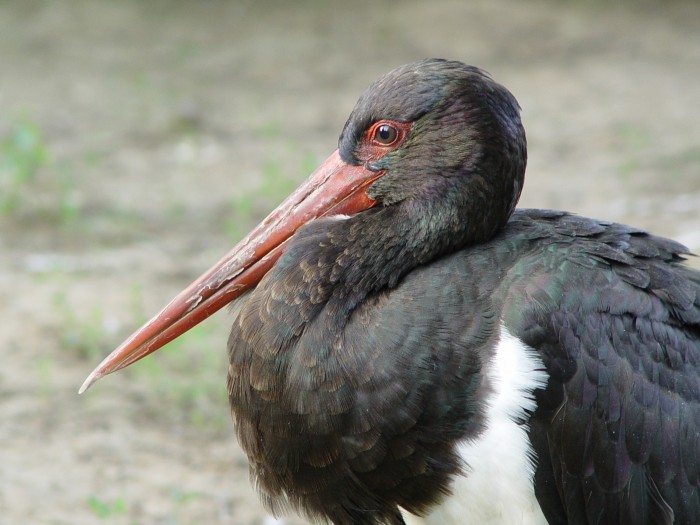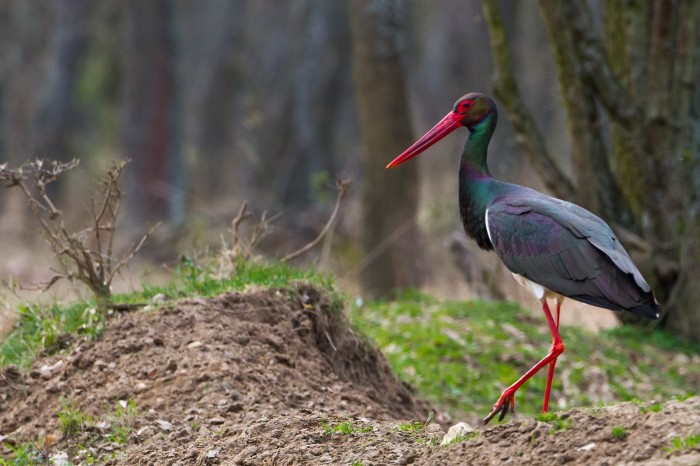A fehér gólyát nem kell bemutatni senkinek, hiszen e nagytestű, könnyen felismerhető madár rendkívüli módon kötődik az emberekhez. Régebben száradó félben lévő magasabb fákra, vagy széles kémények tetejére pakolták fészkeiket. Napjainkra ez javarészt megváltozott. Az úton elhaladva nehéz nem észrevenni a villanyoszlopok csúcsán terebélyesedő hatalmas fészkeket, és az azokon pihenő, vagy éppen elegáns mozdulatokkal kelepelő piros csőrű, fehér-fekete tollazatú madarakat. Nincs ez másképp Őriszentpéteren sem. A látványban annyi a különbség, hogy a jól ismert fészek, a megszokotthoz képest nem egy villanyoszlopra, hanem jóval magasabbra, a város központjában található úgynevezett sárga ház épületének kéményére épült. E gólyapáron kívül nem fészkel több fehér gólya avárosban.

The white stork needs no introduction to anyone, as this large-bodied, easily recognisable bird is closely attached to people. ln older times white storks used to build their nests in higher trees that were already in the process of drying out, or on the top of wide chimneys. Nowadays it has greatly changed. When passing on a road, it is easy to catch sight of the huge nests sitting on the tip of electricity poles with the red-beaked, white-black feathered birds resting or elegantly moving around in them while clattering loudly. This is no different at Őriszentpéter, either. The only difference in this sight here is that the well known nest sits not on the tip of an electricity pole, but at a much higher point, namely, on the chimney top of the yellow house building located in the town centre. Apart from this pair of storks thereare no more whitestorks nesting in the town.

Ha létezik fehér gólya, akkor miért ne létez hetne fekete is? Valóban él egy úgyszintén hosszú lábú, piros csőrű, jókora méretű másik gólya is erre felé, amelynek azonban csak a hasalja fehér, amúgy tollazatának teljes egésze fekete. Messziről teljesen sötétnek tűnhet, ám közelebbről szemügyre véve fekete tollai fémesen csillognak a zöld és a lila legkülönfélébb árnyalataiban. Míg fehér rokona tavasztól nyár végéig minden percben a szemünk előtt van, addig a fekete gólya az egyik legrejtettebben élő madarunk. Általában csak azokon a helyeken telepszik meg, ahol fészke szinte teljesen rejtve marad, a környék zavartalan és megfelelő minőségű táplálékot is talál a közelben. Egy-egy fekete gólyát viszonylag rendszeresen Őriszentpéter légterében is meglehetett figyelni, így a fészkelés lehetőségét már évekkel korábban sejteni. A fészket, és vele együtt a fiókákat viszont csak 2015-ben sikerült felfedezni, így a jelenlegi állás 1:1 – már ami a jelenleg ismert őriszentpéteri fekete- és fehér gólya párok számát illeti! A fekete gólya példája is jól mutatja, hogy számos különleges és ritka élőlénynek ad otthont Őriszentpéter természeti környezete.
If there are white storks, why should not there be black storks, too? ln fact there is another long legged, red-beaked stork of considerable size living in these parts, but its underpart is white, otherwise it is black in its entirety. From a distance it might seem totally dark in colour, but a closer study will reveal the metallic shine and the rich variety of greenish and lilac hues on the black feathers. While its white cousin is continuously before our eyes in every minute from spring till late summer, the black stork is one of our most hiding birds. Normally it settles down in places where its nest would remain completely hidden and the surroundings is undisturbed and can provide food of proper quality. Single black storks had been observed on a relatively regular basis in Őriszentpéter’s air space, so the existence of a black storks’ nest had been suspected tor years. However, it was only in 2015 when the nest and the young black storks in it had been discovered, so the present number of the pairs of black and white storks is 1:1! The example of the black stork well illustrates the fact that the natural environment of Őriszentpéter is home to some really special and rare living creatures.









